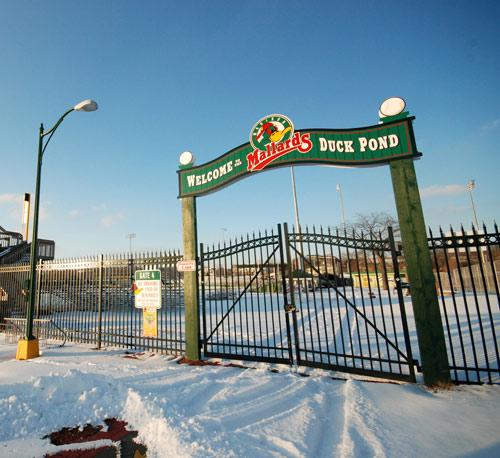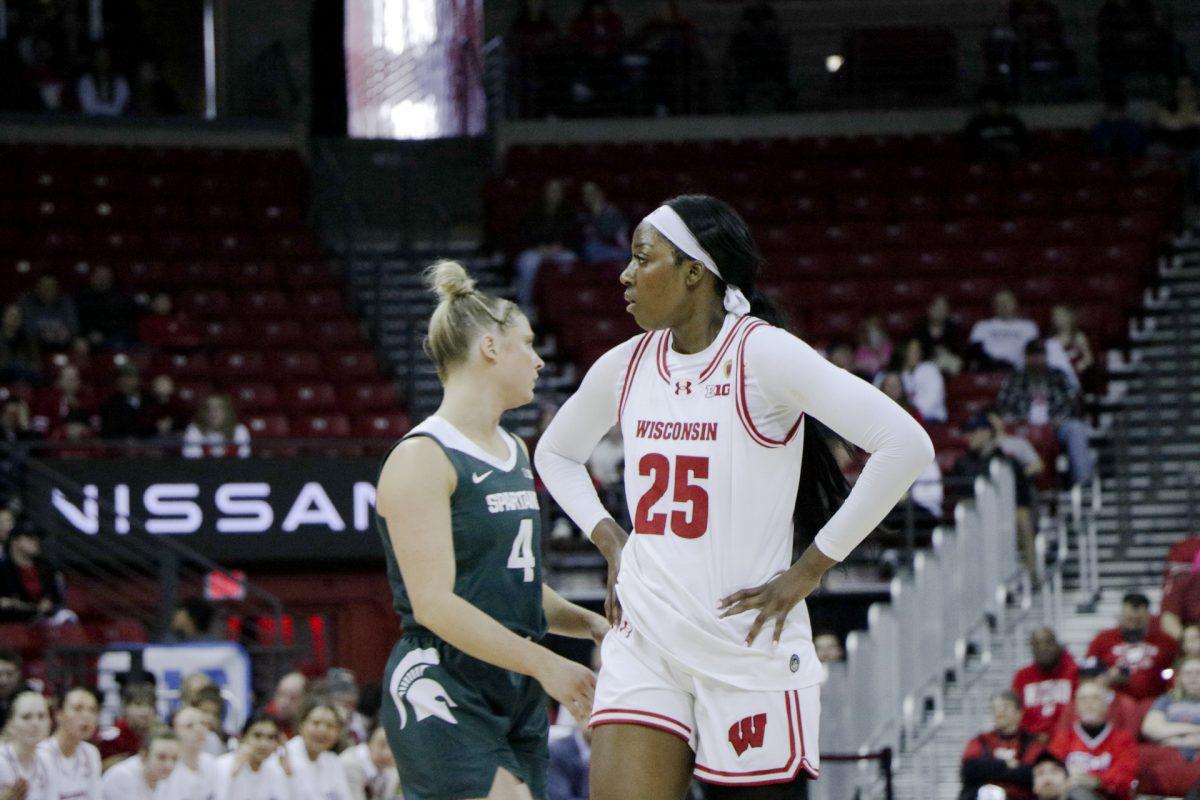Across the country, Big Ten football is held in the highest regard as one of the premiere conferences in college football, because of the history, the tradition and the consistently high level of competition within the league.
But one of the biggest reasons that Big Ten football is special is the line-up of venues, which are some of the most diverse, historical, exciting and interesting in all of America. So we at The Badger Herald posed the question: which is the best football stadium in a league chock full of dandy facilities?
So we polled our opposite numbers all across the Big Ten, asking other student publications to rank the stadiums throughout the conference in hopes of reaching a conclusion of which stadium stands alone as the unrivaled best facility in the Big Ten.
Without further adieu (drum roll, please) …
Ohio Stadium — Ohio State
Is there a better overall home-field advantage in the conference than the edge Ohio State enjoys at the Horseshoe? Not likely. The Buckeyes certainly are always tough to beat, and their track record in the past few years shows as much. But throw in 104,000 fans in a stadium built with nothing but football in mind, and most teams would probably rather play on hot coals than march into the 'Shoe.
Built in the classic Horseshoe style, another recently renovated facility in the conference rises high and is completely enclosed, amplifying sound the already-raucous fans to what can be earsplitting levels. It might not be the loudest venue, but it is consistently louder than maybe any place this side of Beaver Stadium in the conference.
While Ohio Stadium doesn't quite hold the mystique that Michigan Stadium does, it has more than its fair share of history, as Woody Hayes used to stomp the sidelines, and many a championship has been won on the Columbus turf. The dotting of the "i" in the Script Ohio is one of the most anticipated traditions in sports and rightfully so.
Michigan Stadium — Michigan
The Big House. It is probably the most notable moniker of any structure in the conference and is definitely the most fitting.
With capacity officially listed at 107,501, it is far and away the largest football stadium in the country, with attendance regularly exceeding 110k, though you wouldn't guess it. The design of the structure — a gigantic bowl sprawling outward and not very much upward — leaves many other home fields looking larger to the eye.
Michigan Stadium isn't just home to Michigan football, it is home to everything that defines what Wolverine ideals are. You won't find so much as a scrap of advertising anywhere, and no seating starts closer to the field.
"With just over 20 rows above the ground, walking into the bowl is an experience a Michigan fan will never forget," said Kevin Wright of the Michigan Daily. There's nothing like hearing over the loudspeaker, "You are part of the largest crowd watching football in America today." Still, the Big House gets a bad rap for being too quiet for its capacity. Presently, a debate over a luxury-box addition to the stadium rages, with those in opposition citing the tradition of the bowl over the commercialization of Michigan Stadium.
Built in 1927, however, the place is definitely showing its age, and every penny of a $250 million renovation will likely be needed to give the Big House a noticeable makeover. It isn't particularly fan-friendly with acoustics and the seats move away from the field quickly. While Michigan fans are undeniably rabid, it isn't represented in the crowd noise, as it can be described truthfully as being the quietest 110,000 people you will ever find.
The history and aura surrounding Michigan Stadium, however, make it a must see.
Whether it is a must-see twice — that is up for debate. It also doesn't help to have the landfill known as Crisler Arena dominating the skyline.
Camp Randall Stadium — Wisconsin
Camp Randall Stadium is probably the best blend of a historic venue melded with modern renovations, and in many ways the stadium is a blueprint for how future renovations at schools will be done. The Camp still maintains its feel as an ancient cathedral to football, especially with the UW Field House forming the wall on the south side, overlooking the complex.
Formerly a traditional horseshoe, Camp Randall is now a very modern, fully enclosed stadium with an upper deck on the west side. While much of the stadium is new and shiny, the attitude of the fans is decidedly old school. The fans tend to show up early (with the exception of some students doing some last-minute celebrating) and stay late with the Fifth Quarter being one of the most unique traditions in the country.
The students set the tone, are some of the rowdiest and most colorful in all of football and can make Camp Randall absolutely intimidating. When revved up, the crowd is arguably the loudest in the Big Ten, but even the most die-hard Badger fans, unfortunately, also seem to care only when they are most needed and thus can be some of the quietest at times, particularly on early downs in nondescript games.
Still, the atmosphere is similar to that of one big party, no better epitomized than by the most exciting two minutes in sports: 'Jump Around,' which leaves opposing players looking on in awe, the press box shaking like a turbulent airplane and the UW players ready to turn it up another notch.
Beaver Stadium — Penn State
If Yankee Stadium is the house that Ruth built, Beaver Stadium is the house that JoePa built.
Nestled in the center of Happy Valley, this giant monstrosity that resembles an erector set is one of the premiere structures in all of college football, having grown with the aura and mystique that surrounds head coach and resident hero Joe Paterno.
The place is enormous, holding over 107,000 fans, and unlike the Big House, looks the part, towering over the field in all directions. The student section, which practices the "White Out" technique, was described by ESPN's Kirk Herbstreit last year as the best in the nation.
"It might not be the most aesthetically pleasing stadium in college football, but Beaver Stadium is, without a doubt, one of the loudest," said Justin Kunkel, sports editor of the Daily Collegian in State College. "When the whited-out crowd bounces to 'Zombie Nation' after a big defensive play, the world's largest erector set literally shakes and sways. It also gets props for its sheer size. Sitting on top of a hill to the north of campus, Beaver Stadium is one of the most physically imposing structures in all of football."
Other plusses include possibly the best tailgating scene in the conference, as it takes about 10 days to completely clean up the area surrounding the stadium following a game, and the stadium has, without question, the most welcoming and friendly fans you are ever likely to find.
When walking around the perimeter of Beaver Stadium wearing opposing colors, you are likely to be welcomed so often as to feel you might be a celebrity, and picking up a complimentary beer and hoagie from tailgaters is hardly out of the question.
Kinnick Stadium — Iowa
Fresh off a renovation, the new and improved Kinnick Stadium will lose its big-game virginity this week when No. 1 Ohio State comes into town for a night game.
"Just $89 million later, one must admit Iowa's two-year renovation project bears impressive results," said Tyson Wirth of the Daily Iowan. "A statue of Nile Kinnick greets fans on their way into the arched brick south entrance, just a Hail Mary from the new press box. The only negative is students are now forced into the stadium's corner, as better seats go to contributors."
Kinnick's fans and atmosphere are right up there with Wisconsin and Penn State as the class of the conference. It also could be in the running as the loudest venue.
It's undeniable that the Hawkeyes perform better there, as they have had something of a renaissance over the past few seasons, much of that fueled by dominance at home. The water tower looming over the stadium is a nice touch and speaks to the blue-collar feel of Kinnick.
Ross-Ade Stadium — Purdue
Let's face it. Nothing about West Lafayette is sexy. It's in Indiana, and most people outside of the state couldn't find it on a map. But it does have a rather devoted bunch of fans, consistently drawing a full house at Ross-Ade that makes it a very hostile environment for opponents at times.
"One of the best things about newly-renovated Ross-Ade Stadium is that the
fans are extremely close to the field," said Leroy Bridges, sports editor of the Purdue Exponent. "Sure, 63,000 fans aren't as many as Michigan, but the proximity of all of the heckling and noise creates a great atmosphere for every home game."
Before the recent $70 million renovation, Ross-Ade Stadium sort of resembled a high school field on steroids, with a simple horseshoe complemented with auxiliary seating in the open end zone. Following the renovation, it suddenly looks an awful lot more impressive, especially with the gigantic press box and luxury boxes dominating one end of the stadium. The playing surface is (gasp!) natural, which is quite the bonus.
Spartan Stadium — Michigan
Spartan Stadium is often sort of a forgotten stepchild in the ranks of Big Ten stadiums. At about 75,000 seats, it is the fifth-largest stadium in the conference and its fans are loyal, providing a sea of green for most home games.
The locale couldn't be better, in terms of matching the very suburban-feeling campus in East Lansing. The tailgating is solid, the crowds are loud and the overall atmosphere is a good one.
So what holds it back? Simply that there is no one aspect of the facility that truly makes it stand out, like the capacity of Michigan, or the atmosphere of Penn State and Wisconsin. Spartan Stadium is probably the clear dividing line between the upper echelon and second tier of Big Ten stadiums.
Ryan Field — Northwestern
As sleepy a stadium as you are ever to find, Ryan Field is usually good for at least one upset if only for the lax atmosphere that can lull opponents into a malaise, which is never good when going up against an offense that routinely lights up the scoreboard like the New York Stock Exchange.
"Ryan Field doesn't have lights, but it does have action," said Zach Silke of the Daily Northwestern. "It's small, but it has heart. Just wear some purple and have a ball."
The stadium looks neat on the outside, but once inside, the lack of crowd noise — and often the lack of a crowd — as well as any real collegiate feel makes Ryan Field one of the least exciting spots to watch a game in the Big Ten.
The Hill behind the end zone is somewhat ludicrous, reminiscent of Minute Maid Park.
Metrodome — Minnesota
A multi-purpose dump built in 1979, the Metrodome is a relic of days past, when inexpensive, highly useful facilities were chic and the idea of having a roof over a field was neato. No more. Today, it is seen as simply the greatest example of why to avoid a jack-of-all-trades structure.
It is the only stadium in the Big Ten that really has no affiliation to the school that plays in it, as Minnesota is just simply another tenant in the building. On game days, you are as likely to see Vikings and Twins paraphernalia as you are to see any sign that a college team might play there. Tailgating is nonexistent, the crowds are poor since it's off campus, and the acoustics are horrendous.
Don't believe me? Feast your eyes on this …
"There isn't a passion for football at the Metrodome like there is at other Big Ten schools," said Charles Spring, sports editor of the Minnesota Daily. "The Metrodome is not a place to watch college football. Blame it on the stadium or the product on the field or the fans; it doesn't really matter because they're all to blame. The Metrodome is simply the worst place for football in the Big Ten."
Memorial Stadium — Illinois
Memorial Stadium is something of a sad story in the whole scheme of Big Ten venues. It can lay claim to having a great history, with Red Grange once running over opponents there.
Aesthetically, it still works with a very nice setup — a small lower-bowl horseshoe with upper decks on either sideline — and is decorated with 200 timeless granite columns on which are inscribed the names of Illinois men who died in battle in American wars. Old-school light standards that draw memories of Tiger Stadium in Detroit dot the four corners of Memorial.
"Illinois may have the worst football team in the Big Ten, but its stadium ranks middle of the pack," said Courtney Linehan, who covers football for the Daily Illini.
But for all of its beauty, it still is unimpressive. The reason: poor attendance and an even worse fan atmosphere. Much of that is due to the horrendous product the Illini have put on the field, as you can tell the fans are growing weary of not just losses, but blowouts. Continuing on the theme, Illinois is working on a monster renovation that will hopefully reenergize the fan base and make this house great again.
"It is not the newest or most technologically impressive stadium in the Big Ten, but look at Wrigley Field," Linehan said. "Even a non-Cubs fan like me has to admit there's something fantastic about an old-school stadium."
Memorial Stadium — Indiana
The second and lesser of the two Memorial Stadiums, Indiana's has been dubbed "The Rock" by second-year head coach Terry Hoeppner, who believed the site was in need of an identity … and boy, was he right.
The most notable feature of Memorial Stadium previously was the bizarre, unsymmetrical shape of the main grandstand with the west-side bleachers dwarfing those on the east sideline.
In terms of atmosphere, well, it has been said that there are at times more fans tailgating outside the stadium than watching the game within.
"'The Rock' seats more than 52,000 cream and crimson fans," said Matt Mattucci of the Indiana Daily Student. "Though it is rarely jam-packed, Memorial Stadium will soon see some renovation, with the addition of a tower in the north end zone and some additional seating. Thousands of fans flock to the Woodlawn Fields across the street to tailgate before games."
A sparkplug coach, Hoeppner has tried instituting a variety of new traditions, including placing a three-ton chunk from the original Memorial Stadium in the North end of the stadium symbolizing 'The Rock'.













